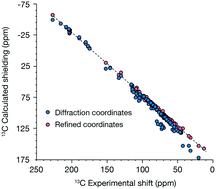Refining crystal structures using 13C NMR chemical shift tensors as a target function†
Abstract
A two-step process is described for refining crystal structures from any source. This approach employs an initial lattice-including DFT relaxation step followed by a Monte Carlo sampling procedure to create new candidate positions for each atom within a structure. The candidate having the best agreement between experimental and computed 13C NMR shift tensor principal values is selected for further refinement and the Monte Carlo process is repeated until convergence is achieved. This refinement can include all atoms within a structure or can be restricted to only poorly fit sites. This process is shown to improve 13C NMR agreement from 6.1 ppm for a set of benchmark structures obtained from high quality diffraction data and not subjected to any refinement to 1.8 ppm after the two-step refinement. Although changes to atom positions from this refinement process are quite small (usually a few picometers), prior work is summarized to demonstrate that these changes can, in fact, yield new structural insights involving changes in hydrogen bonding, detection of hydrogen tunneling and new insights into protein backbone dynamics. Several non-NMR metrics, examined before and after refinement, indicate that this process does not introduce structural errors.



 Please wait while we load your content...
Please wait while we load your content...